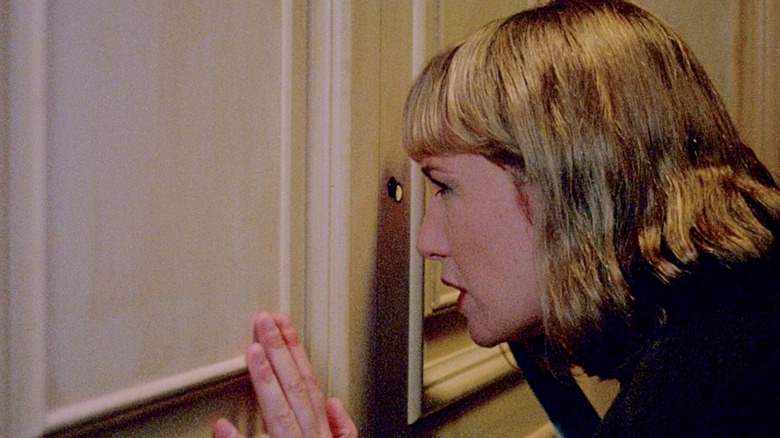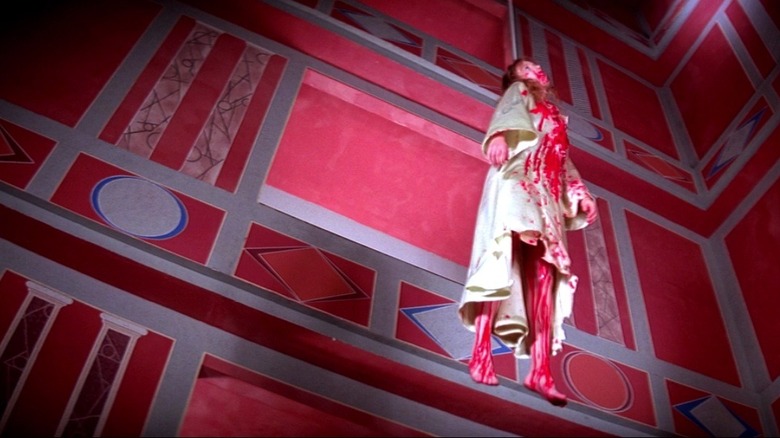A Normal Death Just Isn't Enough In A Dario Argento Horror Film
What do you think of when you think of a Dario Argento movie? "Goblin" music? A garish giallo color palettes? Bad English dubbing? All of the above are Argento trademarks, but there's one other key ingredient: gallons of blood. The director revels in subjecting his characters to grisly demises. Other directors might be content with deaths lasting a few seconds and shocking the audience for as long. Argento's characters, though, suffer drawn-out deaths that run for whole minutes. Usually, it's a death by a thousand cuts too.
Take "Suspiria": The first casualty comes when Pat Hingle (Eva Axén) is grabbed then stabbed by an unseen attacker; there's a close-up of the knife penetrating her exposed heart. Pat's corpse is flung through a stained glass ceiling with a noose around her neck and the falling glass splits her friend Sonia's (Susanna Javicoli) head in half.
The most outrageous Argento death is in his 1987 "Opera." When a woman looks through a people, the door knocker fires his revolver through the hole. The scene decelerates to slow-motion as the bullet launches through peephole, shattering it along the way. The film cuts back to wide shot of woman's brain getting blown up; she falls in slow motion as distorted scream echoes.
It's not only innocents who suffer such deaths in Argento films, though. Frau Bruckner (Daria Nicolodi), villain of "Phenomena," is stabbed to death with a straight razor. Of all "people," the killer is the pet chimpanzee of one of her victim Prof. John McGregor (Donald Pleasance).
According to Argento, the only limit to these deaths is his imagination: "All of the [deaths] I've imagined I have shot." How does he bring his imagination into reality, though?
Conceptualizing the murders
In 2019, Argento spoke with Interview Magazine and explained how his death scenes come to life:
"I visualize [the deaths] when I write and I just let my imagination go. As for the research process behind the killing strategy, I take into account the particular moment in the plot and the character's psychology in the scene. Some death scenes have been more successful than others. I'd have to mention the ones in ['Deep Red],' 'Suspiria,' 'Tenebre,' and 'Opera.'"
Indeed, those four films are some of Argento's most critically well-respected works. As for character psychology, the one that springs to my mind is the death of Sara Simms (Stefania Casini) in "Suspiria."
Forgetting how curiosity killed the cat, Sara investigates the witch coven and finds herself being chased. She climbs through a window to escape but on the other side is a pile of barbed wire. She falls into it and fatally cuts herself all over by writhing around in a doomed attempt to escape. Beyond being a gruesome way to go, the barbed wire is an extension of Sara's mindset in the nightmarish chase: every option leads to death with no way to escape.
Acting out Sara's death scene doesn't sound fun, but according to Argento, finding the right performance hasn't been a problem for him:
"No, it wasn't hard for me to have fun with the actors and their macabre deaths. Once they understand their part, the actor interprets it to his or her best, following my prompts. And then when I'm editing the film, it's my job to find the right moment in the acting."
The death scenes are Agento's from conception to realization and his actors are just one of the pieces he uses to achieve them.

